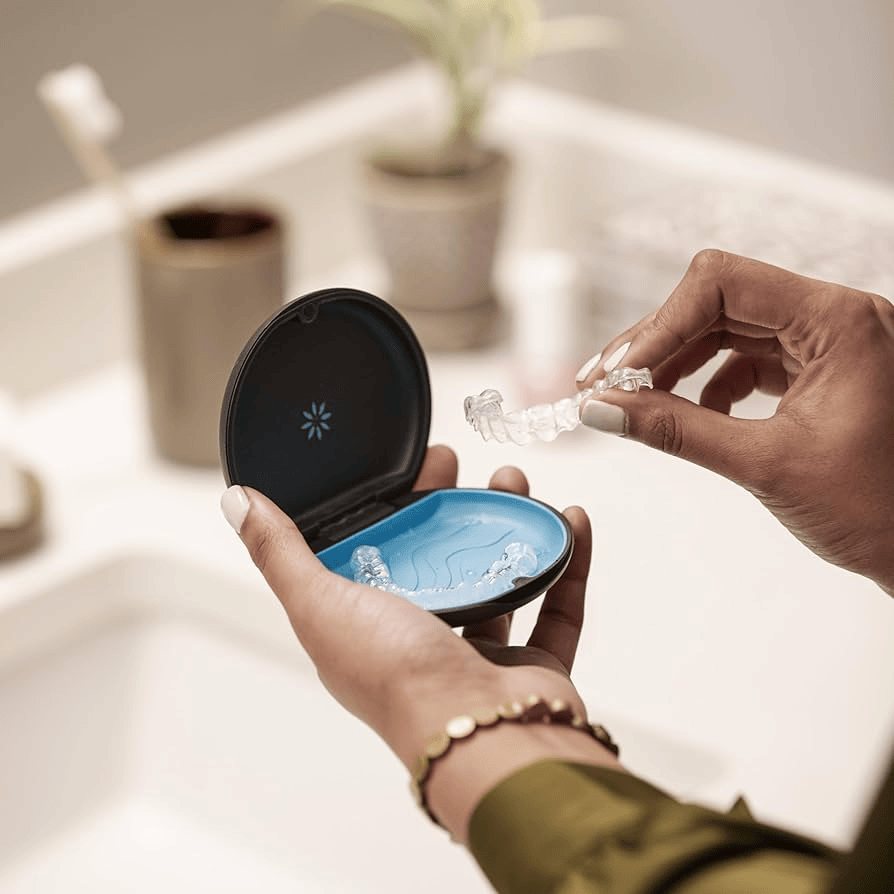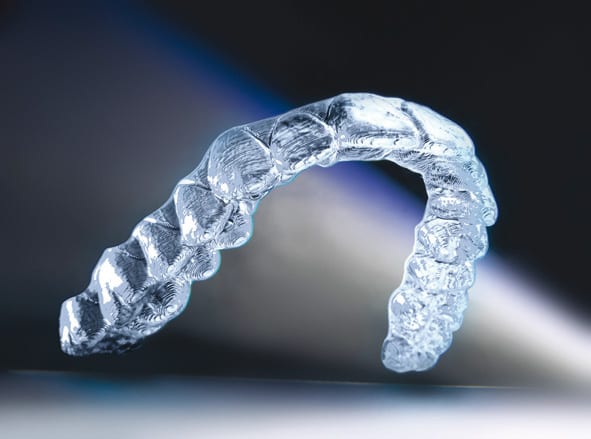If you break or crack your Invisalign aligner, immediately contact your dentist or orthodontist. Depending on the severity of the crack and where you are in your treatment plan, they may advise you to continue wearing the current aligner, switch to your next aligner, or revert to your previous one while a replacement is ordered.
Table of contents
What to Do If Your Invisalign Tray Breaks Mid‑Treatment
A hairline crack in your clear aligner might look harmless, but even a tiny fracture can redirect the tray’s force, warp tooth movement, and add unplanned weeks to your timeline. Most cracks happen during routine removal, when a single, hurried tug overloads one corner of the thermoplastic; others come from chewing with trays in or storing them loose in a napkin. Whatever the cause, ignoring a compromised tray risks uneven pressure, gum irritation, and relapse. This guide lays out exactly why cracks happen, when to call your provider, safe stop-gap fixes, and how to keep treatment on track—all backed by the latest patient surveys and orthodontic recommendations.
Causes of Invisalign Trays to Crack or Break
Repeated flexing and point-pressure fatigue are the kryptonite of medical-grade SmartTrack plastic. Most fractures trace back to one of five habits: hurried single-sided removal, clenching while trays aren’t seated, heat exposure, eating with aligners, or stuffing them in a pocket where they get crushed. Bruxers are prime candidates for micro-fractures because nightly grinding applies off-axis stress, while patients nearing the end of a two-week cycle sometimes see fatigue lines around high-movement incisors. Even if the crack doesn’t split the tray, it can flatten force vectors enough to stall tooth rotation—so vigilance matters from day one.
Improper one-sided “yank” removal
Biting or chewing with trays in place
Storing aligners in pockets or napkins
Teeth grinding or jaw clenching (bruxism)
End-of-cycle material fatigue near high-stress teeth

When to Call Your Orthodontist About a Broken Aligner
Cracks aren’t always a red-alert emergency, but they do demand same-day guidance to avoid back-tracking. Because every tray stage is mapped in tenth-of-a-millimeter increments, even a small split can cancel out targeted pressure. Your orthodontist will check where you are in the wear schedule, review fit, and decide whether to advance, revert, or duplicate the tray. Skip the DIY super-glue—heat and chemicals warp SmartTrack, turning a hairline fault into a banana-shaped tray.
Visible fracture or complete split anywhere along the aligner
Tray feels loose, lifts off molars, or rocks when you bite
You cannot hit 20-22 hours/day without discomfort
Sharp edge cutting gums, cheeks, or tongue
Unsure whether to progress to next tray or revert to previous tray
What to Do at Home While You Wait
Treat a compromised aligner tray like a sprained ankle: stabilize, protect, and prevent further trauma until professional help steps in. First, photograph the crack under good light so your provider can triage by email. Second, park the aligner in its case; pressure from a tight pocket or hot dashboard can exaggerate the split. Orthodontic wax over a sharp edge buys short-term comfort, but never attempt heat-molding or nail-file reshaping without approval—softened plastic loses calibrated stiffness. If you’re early in the wear cycle, your orthodontist may instruct you to pop the previous tray back in; late-cycle cracks sometimes finish the week safely.
Their key functions include :
Photograph the damage for remote assessment
Store the broken tray in its case, not tissue or pocket
Cover jagged edges with orthodontic wax only
Avoid chewing gum, hard foods, or clenching
Wear the previous tray (or carefully continue current one) exactly as instructed
Prevent Aligner Cracks from Happening
Smart removal and proper storage dramatically reduce the risk of Invisalign tray damage. According to clinical surveys, over 40% of aligner cracks occur during removal— often from pulling unevenly or twisting off the front teeth.
Storing trays outside their protective case is another major factor, with nearly one-third of lost or broken aligners linked to being wrapped in napkins, stuffed in pockets, or left exposed. Even drinking hot or sugary beverages while wearing aligners can weaken the thermoplastic over time. Statistically, most damage is preventable with small changes in handling and daily habits.

Use two-hand, back-to-front removal every time
Remove trays for all meals and hot or sugary drinks
Store aligners in their hard case—never napkins or pockets
Rinse cool water only; hot temps soften plastic
Avoid “chewies” if you grind—excess force cracks stressed areas
Time to Book a Dental Emergency?
Timing dictates the fix. A clean split on day 2 usually earns an express reorder and a step back to the prior stage; a tiny fissure on day 11 often means advancing early and wearing the next tray a few extra days. Modern labs can remake a tray in 3-5 business days, but mailing delays mean proactive scheduling saves treatment time. Keep a running calendar of tray start dates so you and your provider can gauge crack-to-cycle ratios quickly.
Days 1–7 with major fracture → revert and order replacement
Days 8–14 with minor crack → advance early, extend next tray wear
Complete break any time → pause use and await professional directive
Replacement turnaround averages 3–7 days; schedule ASAP
Track wear dates to streamline decisions with your orthodontist
Why did my Invisalign crack?
Your Invisalign tray likely cracked due to uneven pressure during removal, chewing with the tray in, grinding your teeth at night (bruxism), or general wear and tear—especially toward the end of a two-week wear cycle. These factors weaken the plastic and increase the risk of fractures.
Can I wear Invisalign with a small crack?
You may be able to wear your Invisalign tray if the crack is small and you are near the end of your wear period, but only if your orthodontist approves it. Wearing a damaged tray without guidance can disrupt treatment and cause discomfort.
What happens if you break your Invisalign tray?
If your Invisalign tray breaks, contact your orthodontist right away. They will evaluate the damage and may advise you to wear your previous tray, move on to the next one early, or order a replacement to avoid delaying your treatment.
What should I do if I dropped and stepped on my aligner?
If you dropped and stepped on your Invisalign aligner, stop wearing it immediately and store it in its case. Contact your orthodontist for next steps—they may recommend switching to your previous tray, ordering a replacement, or advancing to the next stage if appropriate.
Can I go a day without Invisalign if it's broken?
You can go a short time without your Invisalign tray, such as a day, without losing all progress—but longer gaps may cause your teeth to shift. To minimize setbacks, wear your previous tray if you still have it and notify your orthodontist right away.






